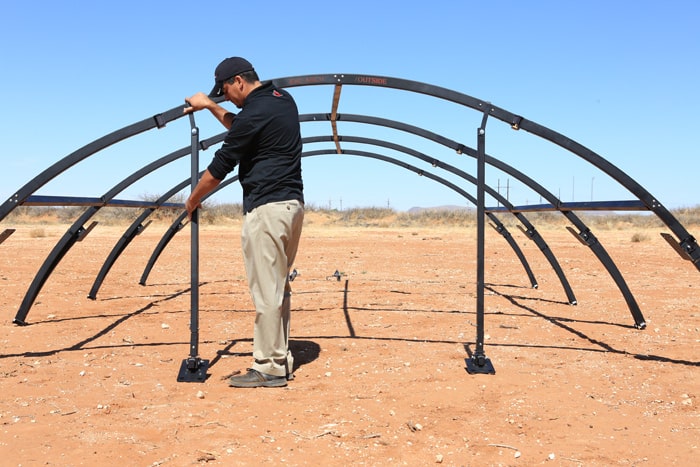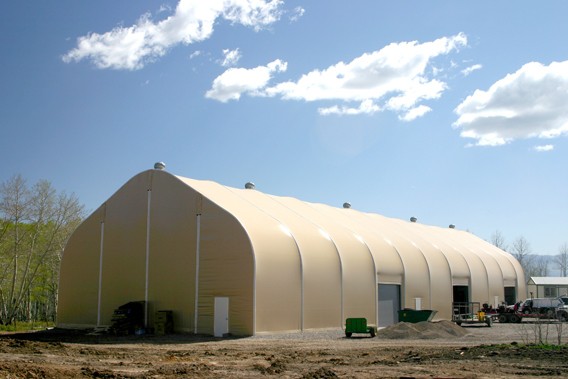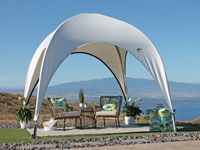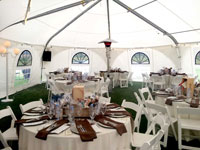Fabric buildings out-perform traditional structures because they’re versatile, strong, and portable. Let’s take a look at the various benefits of tensioned fabric structures.
Cost-Effective
Engineered fabric buildings are extremely cost-effective compared to similar-sized traditional structures made of metal and wood or poles. They involve minimal architectural planning, faster build times, and less expensive materials.
Fabric buildings also accrue savings in the overall assembly and installation process, as well as low to nonexistent maintenance costs.
Faster to Construct
Fabric structure buildings can be set up in a fraction of the time it takes to construct comparable buildings made of traditional materials.
Their assembly and installation features simple instructions due to advanced engineering and design. This is a major benefit when you have regularly changing requirements or if you need to be mobile. For example, fabric structures are useful for trade shows and concert series that routinely relocate to different cities and regions.
Portable
 Fabric structures come in compact, low-cube packaging and are easy to assemble, take down, and relocate. It’s an ideal option if you run a seasonal operation, or if you need to move your facilities to keep up with rotating crops for agricultural purposes, the changing needs of oilfield exploration, moving to different sites for mining, and much more.
Fabric structures come in compact, low-cube packaging and are easy to assemble, take down, and relocate. It’s an ideal option if you run a seasonal operation, or if you need to move your facilities to keep up with rotating crops for agricultural purposes, the changing needs of oilfield exploration, moving to different sites for mining, and much more.
As such, a portable building is a much more versatile structure than a similar-sized, permanent building made of wood, glass, or metal.
[Related: Shipping Containers for Fabric Buildings From Alaska Structures]
Low-Maintenance
The advanced, highly engineered tensile coverings of fabric buildings require minimal to no maintenance, even in corrosive environments replete with salt spray, chemicals, or blowing sand and debris.
You can also opt for protecting the metal frame system with in-house powder-coating from Alaska Structures®. Our optional powder-coating resists damage caused by corrosives, humidity, sea spray and salt air, as well as rust. Traditional buildings, however, require frequent repainting, coating, and new shingles when exposed to normal or severe weather conditions including wind, rain, and snow.
Safe and Durable
Their tensioned polyvinyl membrane is treated with special corrosion-resistant and UV-safe coatings. This protects them from harsh environmental elements and inhospitable climatic conditions.
Fabric buildings are also designed to meet stringent building codes and are able to safely erect in some of the most remote areas across the globe.
Easy to Reconfigure
Fabric structures are a more convenient option than permanent, fixed structures if your facilities need various changes over time.
Fabric buildings feature expansion capabilities and a unique ability to reconfigure or modify to meet your changing needs. For example, if you acquire a vehicle, you may want to expand your carport. Or perhaps you want to enclose a hot tub or pool on your property. In this case, you can expand your fabric structure to accommodate coverage.
Traditional buildings require demolishing and rebuilding to meet your new needs, which is expensive, inefficient, and unsustainable due to increased material use.
[Related: Engineered Fabric Building Applications: How to Use Fabric Buildings]
Allow Natural Light
Fabric structures help you to save on lighting and energy costs since they’re translucent and let in a sufficient amount of natural light. This is ideal for those looking to build a greenhouse or other facilities that require a large amount of light and interior visibility.
Increased natural light also allows fabric structure to remain warm in the winter and cool during the summer, further saving on energy costs associated with running heating and cooling systems.
Additionally, natural light is known to enhance moods, improve workplace productivity, and strengthen sleep quality. These are all useful benefits among workers in remote workforce camps.
Customization Options
Tensioned fabric structures also feature an array of customization options in their design.
You can choose to customize the aesthetic of your structure by choosing from a range of colors. You can also add oversized entry doors, windows, skylights, eaves, and peaked roof areas to fit your operational needs. Adding technical features such as insulation, heating and cooling systems, lighting, shelving, and other storage options are common as well.
Anchor Securely to Any Foundation
Fabric structures are able to securely anchor into virtually any level surface, eliminating the need to be build on solid concrete foundations. This saves on construction costs (in both time and materials), as well as adding to their versatility. F
abric buildings are suitable for many different types of terrain, including remote and inhospitable areas such as the frozen ground in Arctic oil fields, or at ski resorts in the Rocky mountains.
[Related: The Benefits of Engineered Fabric Structures in for Extreme Weather Research Facilities]
Contact Alaska Structures to Learn More About the Benefits of Fabric Buildings
For more information about Alaska Structures or our engineered fabric buildings, contact us today. Send us an email or request a quote and one of our building specialists will be in touch!

















































































Leave a Reply